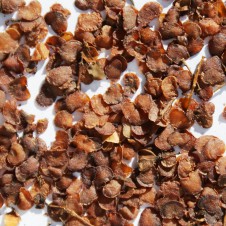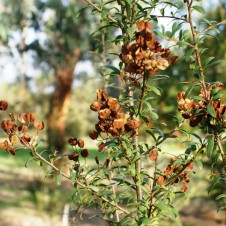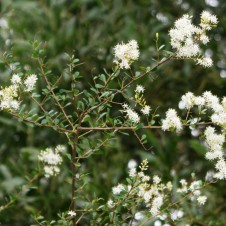General Description: A shrub or small tree, to 6m tall, with small leaves along spiny stems, and dense sprays of white, perfumed flowers.
Flowers and Fruit: Masses of fragrant, creamy-white bunches of flowers at the end of branches. Clusters of bronze seed capsules follow flowering. Flowers from October to March. Fruit is a flat, 2-lobed capsule, to 10 mm long. This plant is sometimes called ‘Shepherd’s Purse’ which refers to the shape of the seed capsules.
Site Preference and Tolerances: Prefers heavy textured soils. It is found on a variety of habitats, usually occurring as a tree in sheltered moist gullies and as a more spindly shrub on drier sites like rocky hill tops and rises.
Life Span: Bursaria’s are hardy, long-lived (80+ years), colonise marginal and disturbed sites and regenerate from rhizomes after fire.
Wildlife Value: This species should be given a high priority in vegetation projects as it provides an important link in biological diversity for a large array of insects, beetles and spiders, for example:
- It is a butterfly food plant and provides food for caterpillars of Bright Copper, Eltham Copper and Dull Copper butterflies.
- The threatened Eltham Copper Butterfly has a close association with a group of ants. The butterfly larvae live within the underground nests of the ants, and emerge at night to feed on their food plant. The ants protect the Eltham Copper larvae while they feed, and in return the ants feed upon secretions from the butterfly larvae which feed only upon Sweet Bursaria. This is an example of a complex plant-butterfly-ant ecological interaction.
- The nectar is usually produced at a time when it provides enough energy for a small wasp which parasitizes eucalypt eating Christmas Beetles. The wasp lays eggs within the body of the beetles and thus helps to control their often virulent and defoliating outbreaks.
- The nectar also feeds wasps which parasitise leaf-eating scarab insects and pasture grubs, Sweet Bursaria also hosts insects that feed on saw-fly larvae that infest eucalypts.
- The thorny foliage is a protective refuge and a source of spider webs for nesting finches and for other small birds.
- Sweet Bursaria helps threatened woodland birds and fauna by providing a more diverse variety of foods over a longer period. A recent ‘state of Australian birds’ publication by Birds Australia said that the disproportional clearance of better quality land has meant that there are now less nectar resources for honeyeaters and insects during summer and autumn which is when the Sweet Bursaria flowers.
Other Values and Uses: It is palatable to stock and can be used for emergency fodder. Makes an excellent hedge and low shelter plant and is useful in multi-row shelterbelts. Good for erosion control due to its fibrous root system and for recharge control as grows well on rocky sites. An effective sun-screening agent (aesculin) can be extracted from the leaves and was used by World War 2 military forces. Traditionly this was collected by boiling the leaves and collecting the resulting surface oil.
Other Scientific Names: Bursaria spinosa ssp. spinosa (“Bursaria” derives from the Greek word bursa, meaning a sac, pouch or purse-like structure and “spinosa” refers to the spiny/thorny nature).
Other Common Names: Australian Blackthorn, Blackthorn (Tas, NSW), Kurwan (Koorie name), Native Blackthorn, Native Box, Prickly Box (Tas), Tupy (Koorie name), Christmas Bush (South Australia), Whitethorn, South Australian Christmas Bush, ‘Shepherd’s Purse’ which refers to the shape of the seed capsules.
Germination Information: Cold treatment (4C for 3 to 4 weeks) improves results but our seed is stored at this temperature so this has already been done. Seed should be sown in June/July when day temperatures are about 10C and night about 5C. Seed usually has good results in about a month.



